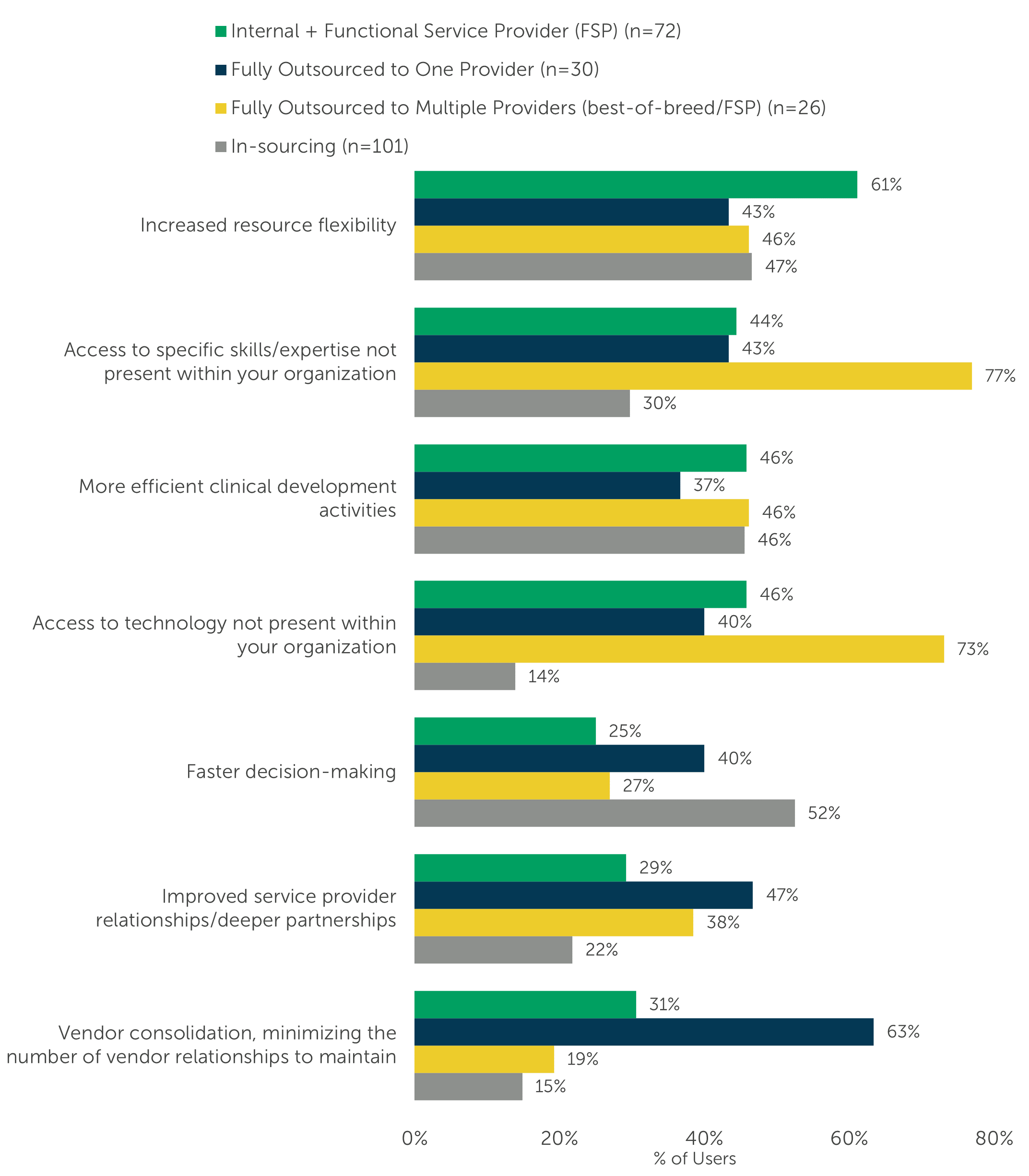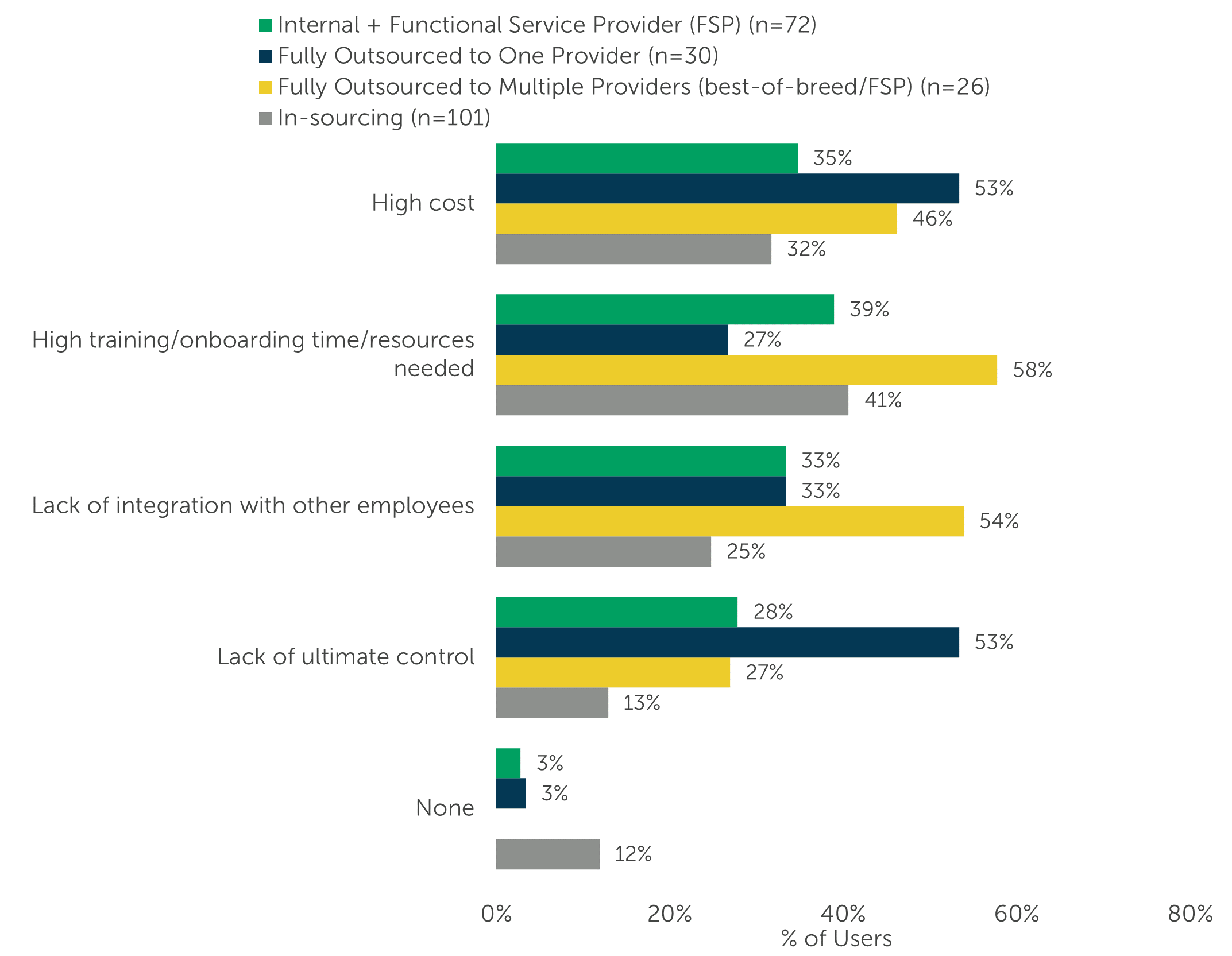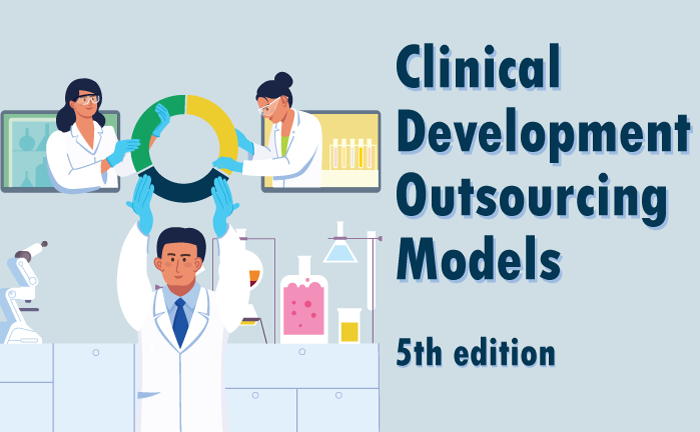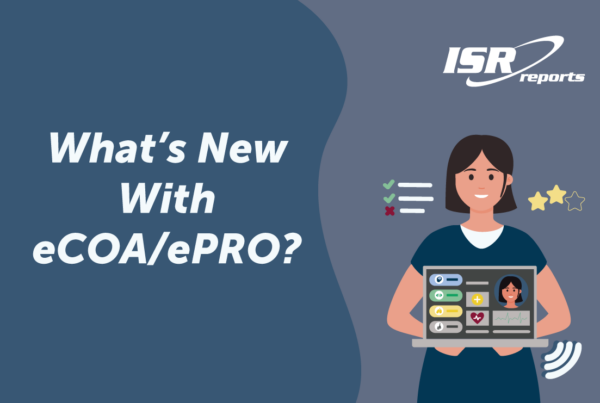Perspectives on Clinical Development Outsourcing
Outsourcing plays a vital role in the clinical development programs of biopharmaceutical companies, offering increased flexibility; access to external expertise and technological advancements; and improved efficiency. Our research on clinical development outsourcing models provides valuable insight into the outsourcing strategies employed in the clinical trial space. Respondents at midsize ($100M to $999M annual R&D) and large ($1B+ annual R&D) sponsor organizations shared their perspectives on the benefits and drawbacks they experience when using the following approaches to outsourcing clinical development activities:
Internal + Functional Service Provider (FSP)
A sponsor executes some clinical development activities for a study internally but outsources all or most of one or multiple functions (e.g., data management, biostatistics, pharmacovigilance, etc.).
Fully Outsourced to One Provider
A sponsor outsources all services for a study to a single CRO. The CRO may or may not subcontract to other providers.
Fully Outsourced to Multiple Providers (best-of-breed/FSP)
A sponsor fully outsources the execution of a study but contracts directly with various “best-of-breed” providers to mix and match services for a custom approach to completing a clinical development project.
In-sourcing
A sponsor brings in contractors/personnel from a staffing agency or other service provider to augment internal staff. These resources are managed by the sponsor.
Benefits of Clinical Development Outsourcing Strategies
The most commonly cited benefits across outsourcing strategies, on average, are Increased resource flexibility, Access to specific skills/expertise not present within the organization, and More efficient clinical development activities. A directionally larger proportion of users cited Increased resource flexibility as a benefit of the “Internal + FSP” model, suggesting that leveraging internal resources with supplemental support from functional service providers (FSPs) offers the most bespoke approach to managing clinical development activities.
The “Fully Outsourced to Multiple Providers” model is perceived to enable Access to specific skills/expertise not present within the organization by over three-quarters of survey participants who use the strategy. Furthermore, this strategy was praised for providing Access to technology not available within the organization.
The “Fully Outsourced to One Provider” model stood out for its positive impact on Service provider relationships/deeper partnerships and Vendor consolidation. More than half of users also acknowledged the “In-sourcing” approach for enabling Faster decision-making. In addition to the benefits highlighted here, our research includes data on the outsourcing strategies that respondents think offer Lower costs and boast Lower employee turnover.
Top Benefits of Clinical Development Outsourcing Strategies

Drawbacks of Clinical Development Outsourcing Strategies
The data highlight several trends in the perceived drawbacks of different outsourcing models for clinical development. High costs, High training/onboarding requirements, and Lack of integration were most frequently mentioned as key challenges across the examined strategies, on average.
Over half of users faced a Lack of ultimate control and High costs when employing the “Fully Outsourced to One Provider” model. Users of the “Fully Outsourced to Multiple Providers” approach were more likely to face challenges with High training/onboarding time and Lack of integration with other employees, suggesting that managing multiple providers in this model can necessitate increased oversight from sponsors to ensure synergy across teams.
Roughly one in ten reported no drawbacks to the “In-sourcing” strategy of leveraging contractors/personnel from a staffing agency or other service provider. Additional information about which models respondents think lead to Poor work quality are available in our full Clinical Development Outsourcing Models report.
Top Drawbacks of Clinical Development Outsourcing Strategies

Benchmark Your Own Outsourcing Practices
Our Clinical Development Outsourcing Models report offers novel insight into some of the outsourcing models commonly employed in the clinical trial space. Each model presents a unique approach to outsourcing, allowing sponsors to tailor their clinical development projects according to specific needs. By exploring respondents’ perspectives, the report provides a nuanced understanding of how outsourcing models are perceived within the industry. This information can aid sponsors in identifying potential gaps or areas for improvement when adopting different outsourcing strategies. Sponsors can benchmark their own outsourcing practices against industry peers, explore the advantages and disadvantages of each model, and gain insights into respondent perceptions of the best and worst outsourcing strategies for different clinical trial scenarios. They can also understand how other outsourcers employ service providers, including the use of strategic partners and preferred providers.
Additionally, service providers can gain valuable insight into sponsors’ outsourcing decisions, understand sponsor satisfaction with different outsourcing models, identify the top drivers for changing outsourcing strategies, and align their services with predicted trends in the clinical outsourcing space. This information can help service providers better understand the needs and preferences of sponsors and tailor their offerings to meet those needs effectively.
Market research data in this article were powered by the ISR Health Panel. Want to contribute to thought leadership pieces and help to make the pharma industry better? Join today.




